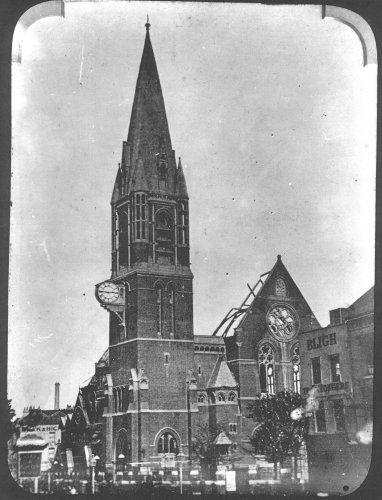Max Levitas, (Communist councillor of the former Stepney Borough, of Jewish heritage) a veteran of the 1936 Battle of Cable Street, addresses the crowd at Altab Ali Day, May 4th 2012, from the Shaheed Minar, a copy of the Bangladesh memorial to the Bengal language martyrs of the 1950s. For more photos click here
click here for photos
Altab Ali Park has been has been revamped to designs by MUF ArtArchitecture. The Park was named after a local clothing worker who was brutally murdered by racists in the 1970s in Adler Street (named after a famous rabbi). It was formed out of the churchyard for St Mary Matfelon (photo of the 19th-c church left, after a fire). A great many famous - or infamous - people were buried in the churchyard, including the executioner when Charles I was beheaded (Richard Brandon , tho' he may not have wielded the fatal blow).
The church is first referred to in the 13th century, though its origin may be substantially earlier than that. It became a parish church in the 14th century and it leant its common name of the White Chapel, to the parish and district of Whitechapel. There are no reliable images of the medieval church, but it is known to have been extended in 1591. The medieval church, with its short square tower, is first shown on the Faithorne and Newcourt map of 1658. In 1673 the medieval church was in such a poor state that it had to be demolished. The new church is clearly shown on the Ogilby and Morgan map of 1676. Burials ceased in the churchyard in 1854 and in the 1870s the church was rebuilt again. The remains of the medieval church were discovered in the 1870s after the demolition of the 17th-century church. Observations were recorded by George Birch who stated “on removing the brick walls of the seventeenth century church it was found that they had been entirely built on the old walls of the medieval church”. The new church was barely built when it suffered a fire (pictured) and was rebuilt to look the same. This church was bombed during WW2.
The park was rejuvenated by High Street 2012 and the park reopened formally on March 12th 2012
The design of the new park was informed by an archaeological evaluation
Community dig
and watching brief























No comments:
Post a Comment